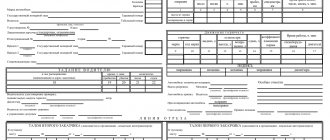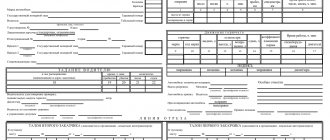Good afternoon, dear reader.
From January 1, 2021, a new regulatory document comes into force - Order of the Ministry of Transport of the Russian Federation No. 368 dated September 11, 2021, No. 368, which introduces new Mandatory details and the procedure for filling out waybills.
This document replaces the Order of the Ministry of Transport of the Russian Federation dated September 18, 2008 No. 152 “On approval of mandatory details and the procedure for filling out waybills.”
The old and new orders are quite similar, each of them talks about exactly what the waybill required for organizational vehicles should look like. However, the new order has several important differences, which in practice will lead to the fact that all organizations operating transport will have to redo the form of the waybill before January 1, 2021. Let's figure out what exactly needs to be indicated in the new waybills:
- New section - information about transportation.
- Indication of the vehicle brand on the waybill.
- Indication of the inventory number for trolleybuses and trams.
- Information about technical control and on-line visits.
- Preparation of waybills for each vehicle.
- Mark on passing a medical examination.
- Mark on passing technical control.
- Exclusion of the storage period for travel documents.
- Maintaining a journal of travel documents in electronic form.
- An example of a waybill according to the old and new rules.
To begin with, let me remind you that a detailed article has been published on pddmaster.ru, which describes the rules for using waybills:
Rules for using waybills
In addition, another detailed article contains instructions for issuing travel documents for various situations:
How to issue a waybill?
New section - transportation information
The first important change was made to paragraph 1, which lists the required sections of any waybill:
1. The waybill must contain the following mandatory details: ... 6) information about transportation.
This paragraph states that from January 1, 2021, each waybill will have a new section “transportation information.” More detailed information on the contents of this section is provided in paragraph 6:
6. Transportation information includes information about types of messages and types of transportation.
That is, each waybill must contain information about:
- in the form of a message;
- type of transportation.
Let me remind you that each of these concepts is disclosed in the Charter of road transport and urban ground electric transport:
Article 4. Types of communication
1. Transportation of passengers, luggage, and cargo is carried out in urban, suburban, intercity, and international traffic. ... Article 5. Types of transportation of passengers and baggage
Transportation of passengers and baggage is divided into:
1) regular transportation;
2) transportation according to orders;
3) transportation by passenger taxis.
Thus, there are 4 options for message types:
- urban;
- suburban;
- intercity;
- international.
The legislation also provides for 3 options for the type of transportation:
- regular;
- by order;
- transportation by passenger taxi.
For example, for a regular bus operating within a populated area, the section should contain the following information: Type of service: urban. Type of transportation: regular.
For a truck that transports cargo between neighboring regions, the section will look like this: Type of message: intercity. Type of transportation: none.
Types of transportation apply only to the transportation of passengers and baggage and do not apply to the transportation of goods. Therefore, the second example uses the value "absent".
Indication of the vehicle brand on the waybill
6. Vehicle details include:
1) the type of vehicle (passenger car, truck, bus, trolleybus, tram) and model of the vehicle, and if the truck is used with a car trailer, car semi-trailer, in addition - the model of the car trailer, car semi-trailer;
4. Vehicle details include:
1) the type of vehicle, make and model of the vehicle, and if the vehicle is used with a trailer (semi-trailer), in addition - the make and model of the trailer (semi-trailer);
Previously, mandatory details required only the model of the vehicle to be indicated; from January 1, 2021, in addition, the make of the vehicle must be indicated. In this case the change is minimal. This is due to the fact that a car model without a brand says little. Therefore, when filling out waybills, employees of most organizations indicated both the make and model.
So, according to this change in the waybill, you will only need to rename one of the points.
Indication of the inventory number for trolleybuses and trams
6. Information about the vehicle includes: ... 2) state registration plate of a passenger car, truck, cargo trailer, cargo semi-trailer, bus, trolleybus;
2) the state registration number of the vehicle, and if the vehicle is used with a trailer (semi-trailer), its registration number and/or inventory number (for trolleybuses and trams);
Previously, subparagraph 2 required that the registration number of the vehicle be indicated on the waybill. However, trolleybuses and trams do not have registration numbers. the inventory number of a trolleybus or tram into the waybill That is, the number that is indicated on board this vehicle.
Sample of filling out a waybill
So, the following are written in order on the sheet:
- date of its preparation;
- name of the organization and its address;
- OKPO code;
- car make (if the car is foreign-made, the model can be entered in Russian transcription);
- state number and garage number (if available);
- information about the driver: his full name, personnel number, driver's license number, driving class. Information about the license card must be entered if the driver operates using a license.
The second part of the form on the left includes information about the task issued to the driver for the current shift. Here are the following:
- who exactly issued the order: structural unit and name of the enterprise;
- delivery address;
- time of leaving the garage (exactly - in hours and minutes);
- signatures of the mechanic and driver.
After the trip, you should note the time of return to the garage, periods of waiting, downtime, destination of trips, etc., and also confirm all this information with the autograph of the driver.
On the right side of the document the following is indicated:
- first, data on the technical condition of the car at the time of departure: speedometer readings certifying the serviceability of the car, signatures of the mechanic and driver, brand and code of the fuel used;
- then, after returning, the fuel consumption is described in detail (the tanker or fuel technician enters the data here): how much was issued according to the refueling sheet (in liters), how much was in the tank when leaving the garage and when arriving back, consumption (standardized and actual), and also information about savings or overspending;
- then the numbers from the speedometer are entered, and the mechanic certifies all this again with his signature.
On the reverse side of the waybill, information about trips made during the work shift is indicated (in order). Here it is written
- the address from which the car left,
- destination,
- departure and return times,
- mileage traveled,
- driver's signature.
Finally, the form is filled out by an accounting employee who calculates the number of hours actually worked, the kilometers traveled, and, based on this, calculates the driver’s wages.
Information about technical control and on-line visits
6. Information about the vehicle includes: ... 4) date (day, month, year) and time (hours, minutes) of the vehicle leaving the parking lot and entering the parking lot;
5) date (day, month, year) and time (hours, minutes) of pre-trip or pre-shift monitoring of the technical condition of the vehicle (if its mandatory implementation is provided for by the legislation of the Russian Federation).
4) date (day, month, year) and time (hours, minutes) of pre-trip or pre-shift monitoring of the technical condition of the vehicle (if its mandatory implementation is provided for by the legislation of the Russian Federation);
5) date (day, month, year) and time (hours, minutes) of the release of the vehicle onto the line and its return.
Subclauses 4 and 5 contain two important changes:
- the points have changed places, that is, it makes sense to change their order in the waybill;
- Instead of leaving and returning to the parking lot, the terms are now used to leave the line and return from the line.
The changes that need to be made to the waybill form are discussed above. And then we will talk about how the procedure for issuing waybills has changed.
Preparation of waybills for each vehicle
9. A waybill is issued for each vehicle used by a legal entity or individual entrepreneur for the transportation of goods, passengers and luggage by road and urban ground electric transport in urban, suburban and intercity communications.
8. A waybill is issued for each vehicle operated by a legal entity and (or) individual entrepreneur.
There has been a fairly significant change in wording at this point. Previously, it stated that waybills are required only in the case of transportation of goods, passengers and luggage. The new edition states that waybills are required for all vehicles of legal entities and individual entrepreneurs. That is, it may seem that waybills become mandatory for all cars, including those that are not used for transportation (for example, cars).
However, in reality this is not the case. First of all, the obligation to fill out a waybill is determined by the Federal Law “Charter of Motor Transport and Urban Ground Electric Transport”, but in this document everything remains the same:
Article 6. Waybills
2. It is prohibited to transport passengers, baggage, and cargo by buses, trams, trolleybuses, cars, and trucks without issuing a waybill for the appropriate vehicle.
That is, if the car does not carry passengers and luggage, cargo, then the waybill is still not mandatory.
In addition, paragraph 8 discussed above has another important difference. In the old edition, 3 types of messages were clearly indicated for which a waybill was needed. As for the fourth type of communication - international transport, waybills were not required for it. However, from January 1, 2021, the wording of the clause changes and it turns out that waybills will also be required for international transport
Waybills will become fully electronic in 2021
Soon you will no longer need to fill out waybills manually; they can be generated electronically. The Ministry of Transport and the Ministry of Telecom and Mass Communications are already working on the project.
From December 2021, companies will begin issuing waybills in digital format - they will be displayed in a unified information system>, which will be launched in mid-2022. Such a database will allow inspectors to see waybills online. For example, in the event of an accident, traffic police officers will be able to quickly find out whether the driver has undergone a medical examination.
Andrey Zanin, head of the commercial sector of AITOB, comments:
Electronic filling of waybills is far from a new feature for vehicle management systems. However, unfortunately, not all software products presented on the transport logistics automation market have such functionality.
The software on the 1C platform by default includes the ability to generate waybills according to the standards of the Ministry of Transport. Currently, in each project, AITOB implements the function of automatically issuing and filling out waybills with data from GLONASS monitoring (based on 1C: TMS Logistics. Transportation Management, 1C: Enterprise 8. Motor Transport Management, 1C: Transport Logistics, Forwarding and Motor Transport Management KORP, 1C:Enterprise 8. GLONASS/GPS satellite monitoring center).
To implement this function, only 4 steps are required:
- In the software, a waybill is issued with the following fields filled in: Vehicle, Driver, Remaining fuel and lubricants, Vehicle mileage from the previous period.
- Automotive trackers and sensors continuously monitor the operation of vehicles, record the location and direction of movement of vehicles, the passage of control points on the route, refueling and actual fuel consumption.
- Tracker data is broadcast online by 1C: Satellite Monitoring Center and promptly enters the transport accounting and management system (1C:TMS, 1C:TLE, 1C:UAT).
- In the accounting system, based on the data received, waybills are automatically filled out, depreciation is calculated, fuels and lubricants, spare parts and consumables are written off, and drivers’ working hours are monitored:
- information about actual mileage is used to automatically calculate vehicle depreciation and calculate salaries for drivers, taking into account output;
- based on data on actual fuel consumption, fuel is written off;
- information about engine hours is taken into account both when calculating depreciation and when writing off fuel and lubricants.
>If the bill is adopted, the Ministry of Transport and the Ministry of Telecom and Mass Communications will require additional integration with the general information system. Such a bill will not only reduce the labor costs of the transport and logistics department of the enterprise, but also eliminate accounting errors that can lead to large financial losses for the enterprise.
As for medical examinations, a project with such functionality for the South Ural Mining Company (AKKERMANN trademark) is now in its final stage. We have set up a two-way data exchange with 1C: Manufacturing Enterprise Management and integration with ESMO, which allows you to monitor the relevance of medical examinations passed by drivers at two factories, in Orenburg and Perm.
The transport industry is undergoing numerous legislative changes, which leads to the inevitable digitalization of processes. Thus, after changing the procedure for issuing waybills from March 1, 2021, the demand for FMS systems (fleet management systems) has increased. That allow:
- Manage supply chains involving various modes of transport and using different types of transportation, on our own and with the involvement of contractors;
- Manage tasks for the transportation of goods, calculate the planned cost of transportation and monitor the stages of task completion
- Plan the work of all departments involved in transportation management;
- Create flights taking into account various parameters and conditions of transportation, manage resources to support them, monitor execution
- Assess the needs for cargo transportation and monitor the provision of these needs;
- Manage the company's tariff policy, pricing and profitability of cargo transportation.
Companies that do not use electronic waybills have 2 years to switch to a digital version of documents. 1C software products provide the necessary functionality for this, which has been successfully implemented in dozens of projects.
If you require advice on the possibilities of using the GLONASS/satellite monitoring system without a subscription fee, purchasing and installing car trackers, digitalizing logistics processes and integrated fleet management systems from , please contact: tel: +7 (495) 419-0842 email
Medical examination certificate
15. The dates and times of the pre-trip and post-trip medical examination of the driver are entered by the medical worker who conducted the relevant examination and certified by his signature indicating the surname and initials.
Based on the results of the pre-trip medical examination, the following information is indicated on the waybill.
Based on the results of the post-trip medical examination, the o.
The new version of paragraph 15 says that from January 1, 2021, a medical worker, in addition to the current date and time and his own signature, will put an additional mark :
- passed a pre-trip medical examination and was allowed to perform work duties;
- underwent a post-trip medical examination.
How exactly such a mark should be placed is not specified, but most likely medical organizations will order the appropriate stamps to speed up the procedure for issuing a waybill.
Let me remind you that until March 1, 2019, stamps on waybills were also mandatory, but then they were canceled.
Mark on passing technical control
161. The date and time of pre-trip or pre-shift inspection of the technical condition of a vehicle are marked by the inspector of the technical condition of motor vehicles or the inspector of the technical condition of urban ground electric transport vehicles who carried out the corresponding control, and are certified by his signature indicating the surname and initials.
16. The dates and times of release of the vehicle onto the line and its return, as well as pre-trip or pre-shift control of the technical condition of the vehicle are marked by the official responsible for the technical condition and operation of vehicles, and certified by his signature indicating the surname and initials.
From January 1, 2021, the technical condition controller, in addition to the date and his signature, must put o.
That is, the situation is exactly the same as with marks for passing a medical examination. Until March 1, 2019, stamps were mandatory, then they were abolished, and from 2021 they are reintroduced.
How to fill out a waybill
The procedure for filling out and registering waybills is given in paragraphs. 8 - 18 Required details and procedure for filling out waybills.
For each vehicle you operate, issue one waybill. If one vehicle is used in shifts by different drivers, you can issue several waybills - separately for each driver (clauses 8, 10 of the Mandatory details and the procedure for filling out waybills).
According to the clarifications of the Ministry of Transport of Russia, one waybill can be issued for several drivers, if the identification of marks on the pre-trip (post-trip) medical examination of each of them is ensured (Letter dated 04.04.2019 N DZ-514-PG). These clarifications relate to the no longer in force Order of the Ministry of Transport of Russia dated September 18, 2008 N 152, but we believe that they can be used as a guide at the present time.
In the name of the waybill, indicate its serial number and type of vehicle (clause 11 of the Mandatory details and the procedure for filling out waybills).
As a general rule, when a vehicle leaves and enters a parking lot, you must enter the date, time, and odometer readings. The authorized person who will do this is appointed by the decision of the head of the organization (clause 12 of the Mandatory details and the procedure for filling out waybills).
If several waybills have been issued for a vehicle (for each driver), then on the waybill (clause 14 of the Mandatory details and procedure for filling out waybills):
• the driver who is the first to leave the parking lot, indicate the date, time and odometer reading when leaving; • the driver who is the last to enter the parking lot - date, time and odometer readings upon arrival.
The medical worker makes notes on the driver's examination on the waybill based on the results of pre-trip and post-trip examinations. Based on the results of the pre-trip medical examination, he puts a stamp “passed the pre-trip medical examination and is allowed to perform labor duties”, the post-trip one - “passed the post-trip medical examination” (clause 15 of the Mandatory details and the procedure for filling out waybills, clauses 16, 17 of the Procedure for conducting pre-trip medical examinations). , pre-trip and post-shift, post-trip medical examinations).
According to the Ministry of Transport of Russia, if the duration of the flight is more than one day, then notes on pre-trip and post-trip medical examinations are placed before and after the flight, respectively. If the driver makes one trip or more during the working day, then such marks are placed before the first trip and after the last trip (Letter dated 04/08/2019 N DZ-531-PG). These clarifications relate to the no longer valid Order of the Ministry of Transport of Russia dated September 18, 2008 N 152, but we believe that they can be used as a guide at the present time.
The official responsible for the technical condition and operation of vehicles carries out pre-trip or pre-shift control of the technical condition of the vehicle, indicates in the waybill the dates and times of release of the vehicle onto the line and its return, as well as carrying out pre-trip or pre-shift control with o (clause 16 Mandatory details and procedure for filling out travel forms).
The legislation does not establish in what sequence, when issuing a waybill, it is necessary to carry out a pre-trip medical examination and pre-trip or pre-shift technical control (Letter of the Ministry of Transport of Russia dated 04/08/2019 N DZ-531-PG). Therefore, you can carry them out in any order.
Register the issued waybills in the waybill registration log. It can be kept on paper, the pages of which must be bound, numbered, and (or) on electronic media. If you keep a journal in electronic form, certify the information with a reinforced qualified electronic signature, and also be sure to provide for the possibility of printing the journal on paper (clauses 17, 18 of the Mandatory details and the procedure for filling out travel forms).
Maintaining a journal of travel documents in electronic form
17. Owners (possessors) of vehicles are required to register issued waybills in the waybill registration journal (hereinafter referred to as the journal).
The journal is kept on paper, the pages of which must be bound, numbered, and (or) on electronic media. When maintaining a journal in electronic form, it is mandatory to print pages of the journal on paper.
18. If the journal is maintained in electronic form, the information entered into it is certified by an enhanced qualified electronic signature.
From January 1, 2021, a new option for maintaining a journal of travel documents will appear - in electronic form . In this case, the information entered into the journal must be signed with an enhanced qualified electronic signature.
As for the traditional paper version of the magazine, this design option also remains possible.
Travel log book
All organizations that have vehicles on their books must keep a log of waybills. There is a unified form for this. To avoid mistakes, read about the filling rules.
For what purpose is a journal for issuing waybills kept?
If you are the owner of a transport company, or the organization has transport in operation, then the law requires mandatory journal keeping (Form No. 8). Transportation of people or goods without such a document is prohibited; the owner may be fined in accordance with the Code of Administrative Offenses of the Russian Federation.
The mandatory requirements for maintaining this document include:
The unified form itself was approved by Resolution of the State Statistics Committee of Russia dated November 28, 1997 No. 78 “On approval of unified forms of primary accounting documentation for recording the work of construction machines and mechanisms, work in road transport.” The form has not changed since then.
Resolution No. 78 puts into effect not only Form No. 8, but also other forms. For example, samples of vouchers for different categories of drivers, from cars to trucks, special equipment and passenger transport. The rules for filling out these forms have changed several times.
Since the waybill is a strictly accountable document, its registration is mandatory. For these purposes, Form No. 8 is required.
However, since January 2013, the use of a unified form has become optional for companies.
Now each organization is free to develop its own document in accordance with the specifics of its activities and in compliance with legal requirements for mandatory details.
- About a formalist mechanic and an idealistic driver
Most companies, however, still use the usual form, having only slightly updated it and made it more convenient. It is approved in the accounting policy of the enterprise. As a rule, a new registration journal is started for each new year. Large transport companies accept a replacement period of one month. It all depends on the volume of traffic.
Requirements and rules for maintaining a journal of travel documents in 2021
The basic requirements for the travel log of waybills are contained in Order No. 152 of the Ministry of Transport of Russia dated September 18, 2008. Form No. 8 allows you to quickly monitor the volume of written-off fuel, record the load of transport of various categories, as well as monitor the delivery of vouchers and their correct filling.
The journal of travel documents is stitched together in the form of a book or you can purchase ready-made ones printed in a printing house. The form itself is a table consisting of 9 columns. Developing your own document will allow you to arrange columns in any order, add them or remove them. The standard form (OKUD 0345008) contains the following columns:
- serial number;
- date of issue of the voucher;
- Driver's full name;
- his personnel number;
- vehicle garage number;
- driver's signature confirming receipt of the ticket;
- the dispatcher’s signature confirming his acceptance from the driver;
- signature of the accountant on receipt of the voucher;
- notes.
Often companies, especially small ones, do not use garage numbers, relying on the state number of the car. This is acceptable, but then it is worth making an adjustment to the standard form by replacing column 5 with “State vehicle registration number.”
- Occupational safety training program for drivers
Sample of filling out the travel log of waybills
When filling out the document, you should be guided by the rules provided for by Order No. 152. The form does not contain calculation information and is quite easy to use.
It is most convenient to make entries manually, but it is also possible to keep a log of vehicle waybills in electronic form.
In this case, it is necessary to print out the register daily and have it signed by authorized persons.
>>>
Like most registration books, the journal has continuous page numbers. It must be sewn according to all the rules, certified by the manager’s signature and seal.
The cover page should contain the following information:
- Company name;
- name of the unit (when maintained for individual units);
- OKPO organization;
- validity;
- responsible for filling out the document.
Responsibility for filling out is assigned by order or job description.
Is it possible to keep a travel log in electronic form?
As we wrote earlier, the accounting book can be maintained either manually or electronically. Since the table contains columns that require the signature of responsible employees (6-8), a full-fledged electronic reporting form will not work. In any case, it is necessary to regularly print out the table, collect the necessary signatures and file it.
In addition, the journal refers to the primary accounting documentation, therefore, during any tax audit it will be among the requested documents.
If you nevertheless decide to keep this document in electronic form, we recommend preparing a register of vouchers for the day and printing it out.
Then, during the day, you will be able to immediately collect drivers’ signatures when issuing sheets and not violate legal requirements.
►Find out what fine you will have to pay for the driver not having a waybill>>>
Source: https://www.trudohrana.ru/article/103884-19-m6-jurnal-ucheta-dvijeniya-putevyh-listov









